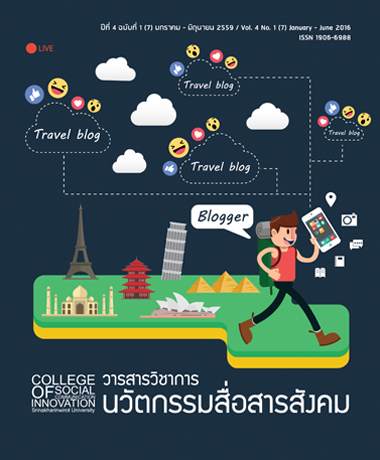ไทยพวนกับกลยุทธเพื่อส่งเสริมการท่องเที่ยวเชิงวัฒนธรรมแบบบูรณาการ
คำสำคัญ:
ไทยพวน, การท่องเที่ยวเชิงวัฒนธรรมแบบบูรณาการ, กลยุทธการส่งเสริม, Phuan people, integrated cultural tourism, promotion strategyบทคัดย่อ
การศึกษาวิจัยเรื่อง “ไทยพวนกับกลยุทธ์เพื่อส่งเสริมการท่องเที่ยวเชิงวัฒนธรรมแบบบูรณาการ” เป็นการศึกษาวิจัยเชิงคุณภาพ ด้วยวิธีการวิจัยเอกสาร(Documentary Research) โดยมีวัตถุประสงค์ 2 ประการคือ (1) เพื่อศึกษาทุนภูมิปัญญาและทุนทางวัฒนธรรมของชาวไทยพว ที่สามารถนำมาใช้เป็นทรัพยากรทางการท่องเที่ยวเชิงวัฒนธรรม (2) เพื่อสร้างกลยุทธ์แนวทางส่งเสริมการท่องเที่ยวเชิงวัฒนธรรมแบบบูรณาการจากทุนภูมิปัญญาและทุนวัฒนธรรมของชาวไทยพวน ผลการวิจัยพบว่า ชาวไทยพวนมีระบบการจัดการการท่องเที่ยวโดยชุมชน เป็นกลุ่มที่มีเอกลักษณ์ทางชาติพันธุ์และมีทุนทางสังคมมาก โดยองค์ประกอบที่สามารถนำมาส่งเสริมให้เกิดการท่องเที่ยวได้คือ ทุนภูมิปัญญาและวัฒนธรรมคือ การนำเอาองค์ความรู้จากตัวบุคคล ชุมชน ภูมิปัญญาปราชญ์ท้องถิ่น นำไปสู่การใช้ประโยชน์และความภาคภูมิใจในความเป็นตัวตน ชาวไทยพวนเป็นกลุ่มที่มีทุนภูมิปัญญาและทุนวัฒนธรรมที่สูงมาก เห็นได้จากความโดดเด่นของวิถีชีวิต ประเพณีที่มีความเป็นสามัญาการดังนี้ (1) การทอผ้าพื้นบ้านของชาวไทยพวน (2) ลำพวนและลำตัดพวน (3) ประเพณีกำฟ้า ซึ่งพบว่ายังคงเป็นสิ่งที่ชาวไทยพวนในหลายพื้นที่ของประเทศไทยยังคงรักษาปฏิบัติสืบต่อกันมา มากน้อยบ้างตามแต่ละพื้นที่ ในประเด็นต่อมาพบว่า เมื่อนำทุนทางวัฒนธรรม ประเพณีของชาวไทยพวนมาประยุกต์กับแนวคิดการท่องเที่ยวโดยชุมชนเชิงสร้างสรรค์เพื่อใช้เป็นจุดดึงดูดใจทางการท่องเที่ยวแล้วนั้นสามารถเสริมสร้างกิจกรรมทางการท่องเที่ยวได้คือ การสร้างโอกาสให้นักท่องเที่ยวได้มีส่วนร่วมในการทอผ้าย้อมสีเส้นด้ายด้วยตนเอง การทดลองแต่งกายแบบชาวไทยพวน การขับร้องลำตัดพวน ตลอดจนการมีส่วนร่วมในประเพณีกำฟ้าที่สามารถสร้างความประทับใจในการท่องเที่ยวได้ โดยสรุป การที่จะพัฒนากลยุทธ์เพื่อส่งเสริมการท่องเที่ยวเชิงวัฒนธรรมแบบบูรณาการ ของกลุ่มชาติพันธุ์ไทยพวนนั้นมีความเป็นไปได้ โดยสร้างความเข้มแข็งให้กับจุดอ่อน คือให้องค์ความรู้ในการจัดการการท่องเที่ยวโดยชุมชนเชิงสร้างสรรค์ เพื่อให้สามารถพัฒนารูปแบบกิจกรรมที่สามารถดึงดูดใจนักท่องเที่ยวได้ และเมื่อสามารถนำมาซึ่งการท่องเที่ยว ก่อให้เกิดรายได้ก็จะทำให้ อุปสรรค คือการขาดความสนใจจากคนรุ่นใหม่ลดน้อยลงเนื่องจากสามารถสร้างงานและสร้างอาชีพในด้านการท่องเที่ยวได้และยังจะมีส่วนร่วมให้เกิดความยั่งยืนทางวัฒนธรรม ดังนั้น กลุ่มชาติพันธุ์ไทยพวนกับกลยุทธ์เพื่อส่งเสริมการท่องเที่ยวเชิงวัฒนธรรมแบบบูรณาการ จึงสามารถทำได้ในรูปแบบการใช้ชุมชนมามีส่วนร่วมในการสร้างสรรค์รูปแบบกิจกรรมที่อยู่บนฐานของทุนทางสังคม ด้านภูมิปัญญาและวัฒนธรรม ประเพณี และในอนาคตสามารถนำกลยุทธ์ไปใช้ในการบูรณาการร่วมกับภูมิปัญญาของชาวไทยพวนในแต่ละท้องที่ของประเทศไทย เพื่อให้เกิดกิจกรรมทางการท่องเที่ยวโดยชุมชนเชิงสร้างสรรค์ ที่สามรถดึงดูดใจให้เกิดการท่องเที่ยวเชิงวัฒนธรรมได้ต่อไปและยังเป็นส่วนหนึ่งในการทำนุบำรุงวัฒนธรรมของชาวไทยพวนไม่ให้สูญหายไปได้อีกด้วย
The Phuan people and the integrated cultural tourism promotion strategy
The Phuan people and the integrated cultural tourism promotion strategy is a qualitative research and a documentary research. The objectives of the research are: (1) To study the local wisdom capital and the cultural capital of Phuan people that can be utilised as cultural tourism resources. (2) To formulate an integrated cultural tourism promotion strategy based on the local wisdom capital and the cultural capital. The research found that Phuan people has been practicing a community-based management tourism. They have a strong ethnic identity and high social capital. The assets that can be utilised and promoted in tourism are their local wisdom and their cultures. The local wisdom is embedded in the community, the local people, and the local philosophers. The local wisdom is truly an asset of the community which brings about the sense of pride to the Phuan people. The local wisdom can be seen through i. the Phuan weaving style, ii. the Phuan traditional dance and music, and iii. the sky worshiping ceremony. All of the aforementioned practices are ubiquitous in the Phuan community nowadays. The research also reveals that when applying the cultural capital and traditions of Phuan people in creative community-based tourism, more activities can be created and can be integrated into the present tourist attractions. For example, allowing an opportunity for the visitors to i. participate in Phuan weaving and dyeing, ii. dress in Phuan traditional dress, and iii. sing and dance along the Phuan traditional dance and music. The sky worshiping ceremony itself is fascinatingly impressive to the tourists. In conclusion,the integrated cultural tourism promotional strategy is feasible when strengthening the weakness of the community which is to provide a knowledge of creative community-based tourism management to the Phuan people so that they can create more activities to attract a large number of tourists. As tourism creates employment and income to the community, it will subsequently attract new generation to participate in the community-based tourism and will preserve the Phuan culture. Therefore, The Phuen people and the Integrated cultural tourism promotion strategy can be practiced by allowing community participation in orderto create tourism activities that are built upon social capital, local wisdom, culture and traditions. The success story can be augmented and appliedin other Phuan communities in other parts of Thailand. The creative community-based tourism offers both economic and cultural benefits asit helps conserving Phuan traditions and cultures.
Downloads
How to Cite
ฉบับ
บท
License
บทความทุกบทความที่ได้รับการตีพิมพ์ถือเป็นลิขสิทธิ์ของวารสารวิชาการนวัตกรรมสื่อสารสังคม มหาวิทยาลัยศรีนครินทรวิโรฒ






